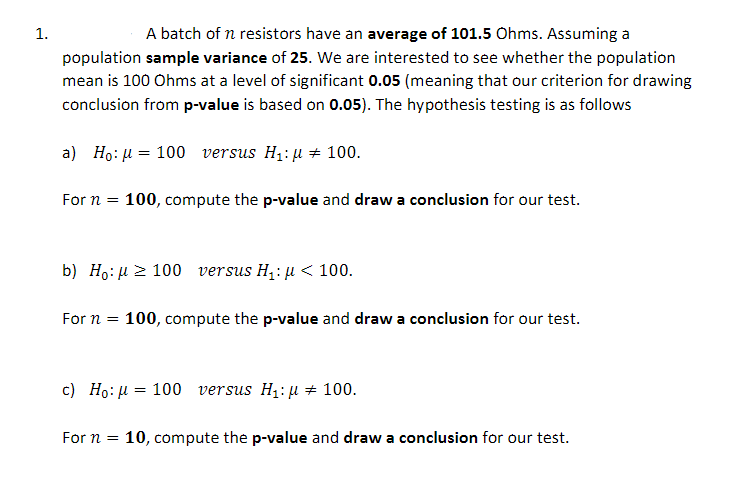1. A batch of n resistors have an average of 101.5 Ohms. Assuming a population sample variance of 25. We are interested to see whether the population mean is 100 Ohms at a level of significant 0.05 (meaning that our criterion for drawing conclusion from p-value is based on 0.05). The hypothesis testing is as follows a) Ho: µ = 100 versus H1:µ # 100. For n = 100, compute the p-value and draw a conclusion for our test. b) Ho:µ 2 100 versus H,: µ < 100. For n 100, compute the p-value and draw a conclusion for our test. c) Ho: H = 100 versus H1:µ # 100. For n = 10, compute the p-value and draw a conclusion for our test.
1. A batch of n resistors have an average of 101.5 Ohms. Assuming a population sample variance of 25. We are interested to see whether the population mean is 100 Ohms at a level of significant 0.05 (meaning that our criterion for drawing conclusion from p-value is based on 0.05). The hypothesis testing is as follows a) Ho: µ = 100 versus H1:µ # 100. For n = 100, compute the p-value and draw a conclusion for our test. b) Ho:µ 2 100 versus H,: µ < 100. For n 100, compute the p-value and draw a conclusion for our test. c) Ho: H = 100 versus H1:µ # 100. For n = 10, compute the p-value and draw a conclusion for our test.
A First Course in Probability (10th Edition)
10th Edition
ISBN:9780134753119
Author:Sheldon Ross
Publisher:Sheldon Ross
Chapter1: Combinatorial Analysis
Section: Chapter Questions
Problem 1.1P: a. How many different 7-place license plates are possible if the first 2 places are for letters and...
Related questions
Question
100%

Transcribed Image Text:1.
A batch of n resistors have an average of 101.5 Ohms. Assuming a
population sample variance of 25. We are interested to see whether the population
mean is 100 Ohms at a level of significant 0.05 (meaning that our criterion for drawing
conclusion from p-value is based on 0.05). The hypothesis testing is as follows
a) Ho: u = 100 versus H1: µ + 100.
For n =
100, compute the p-value and draw a conclusion for our test.
b) Ho: µ 2 100 versus H,: µ < 100.
For n = 100, compute the p-value and draw a conclusion for our test.
c) Ho: µ = 100 versus H1:µ 100.
For n =
10, compute the p-value and draw a conclusion for our test.
Expert Solution
This question has been solved!
Explore an expertly crafted, step-by-step solution for a thorough understanding of key concepts.
This is a popular solution!
Trending now
This is a popular solution!
Step by step
Solved in 4 steps

Knowledge Booster
Learn more about
Need a deep-dive on the concept behind this application? Look no further. Learn more about this topic, probability and related others by exploring similar questions and additional content below.Recommended textbooks for you

A First Course in Probability (10th Edition)
Probability
ISBN:
9780134753119
Author:
Sheldon Ross
Publisher:
PEARSON


A First Course in Probability (10th Edition)
Probability
ISBN:
9780134753119
Author:
Sheldon Ross
Publisher:
PEARSON
